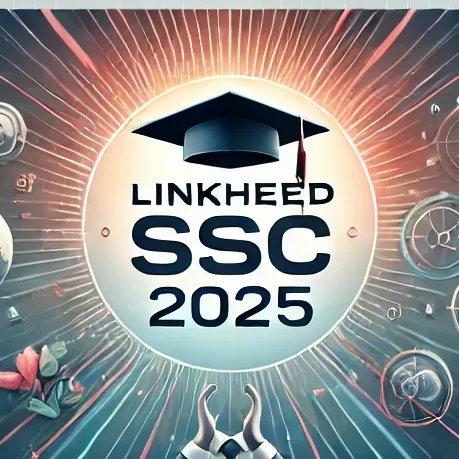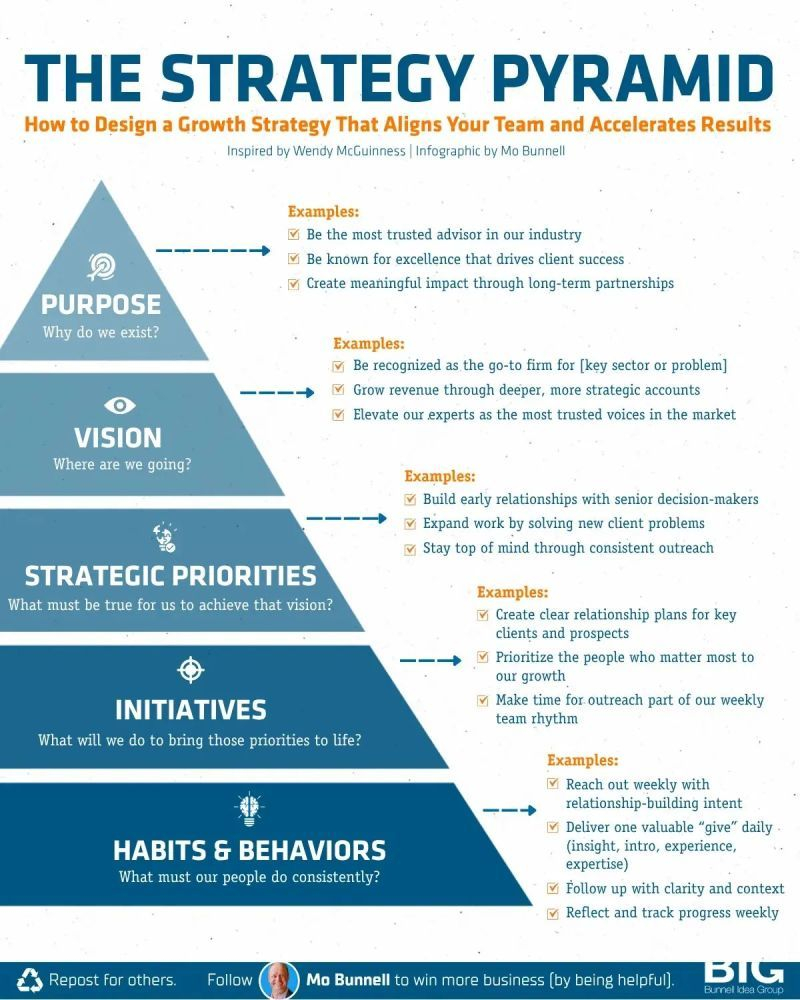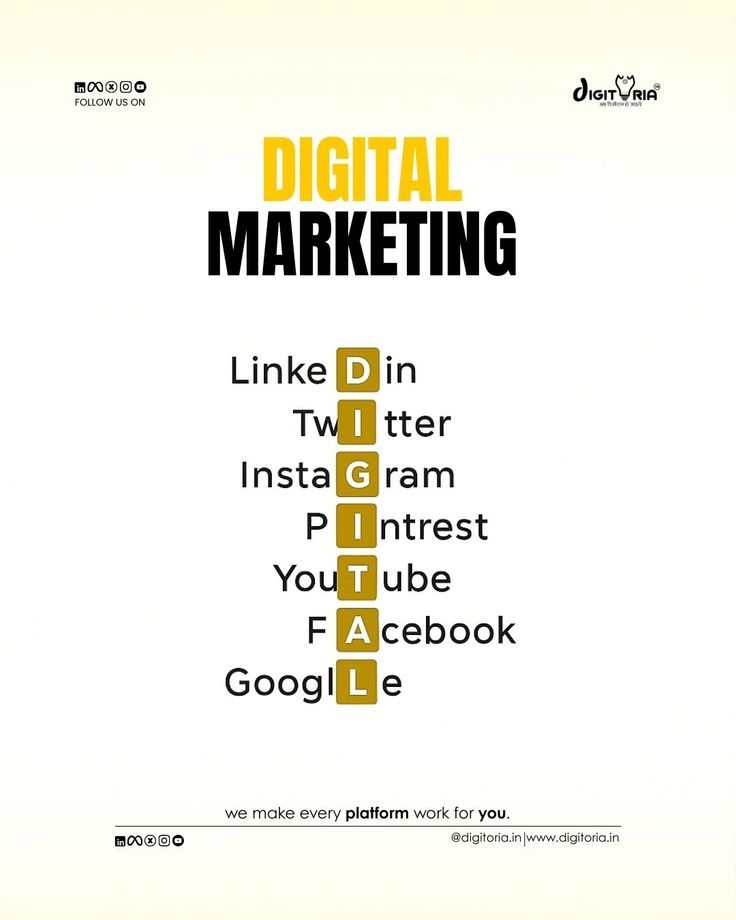I am a Digital Marketer
-
775 Posts
-
1226 Photos
-
4 Videos
-
Lives in Dhaka
-
From Dhaka
-
Male
-
06/04/2000
-
Followed by 5 people
Recent Updates
-
You can’t scale growth by pushing harder.
You scale it by building smarter.
(From the top down.)
Most firms want to grow.
But too many teams start too low on the ladder.
They jump straight to habits and behaviours:
“Make more calls!”
“Close more deals!”
“Send more proposals!”
That creates motion, but not momentum.
The best firms flip the pyramid.
They build business development into their culture.
Starting at the top:
1. PURPOSE
↳ This is why your firm exists beyond making money.
↳ When it’s felt, every client moment matters.
2. VISION
↳ Where you’re headed and what you'll be known for.
↳ A clear vision keeps the team focused on the
right growth.
3. STRATEGIC PRIORITIES
↳ These are the things that must be true to reach
your vision.
↳ They show where to go deep and deliver real value.
4. INITIATIVES
↳ These are the visible plays that bring strategy to life.
↳ Think outreach plans, team rhythms, and
consistent action.
5. HABITS & BEHAVIORS
↳ These are what your team does every day.
↳ Culture grows from small, intentional actions.
Here’s why it works:
When your team starts with purpose, they act
with intention.
When they align on vision, they move in the
same direction.
And when they build the right habits, BD becomes
second nature.
The result?
Your team actually enjoys doing it.
Because it doesn’t feel like selling.
It feels like helping.
Which layer is strongest in your firm?
And which one needs a little lift?
You can’t scale growth by pushing harder. You scale it by building smarter. (From the top down.) Most firms want to grow. But too many teams start too low on the ladder. They jump straight to habits and behaviours: ❌ “Make more calls!” ❌ “Close more deals!” ❌ “Send more proposals!” That creates motion, but not momentum. The best firms flip the pyramid. They build business development into their culture. Starting at the top: 1. PURPOSE ↳ This is why your firm exists beyond making money. ↳ When it’s felt, every client moment matters. 2. VISION ↳ Where you’re headed and what you'll be known for. ↳ A clear vision keeps the team focused on the right growth. 3. STRATEGIC PRIORITIES ↳ These are the things that must be true to reach your vision. ↳ They show where to go deep and deliver real value. 4. INITIATIVES ↳ These are the visible plays that bring strategy to life. ↳ Think outreach plans, team rhythms, and consistent action. 5. HABITS & BEHAVIORS ↳ These are what your team does every day. ↳ Culture grows from small, intentional actions. Here’s why it works: When your team starts with purpose, they act with intention. When they align on vision, they move in the same direction. And when they build the right habits, BD becomes second nature. The result? Your team actually enjoys doing it. Because it doesn’t feel like selling. It feels like helping. Which layer is strongest in your firm? And which one needs a little lift?0 Comments 0 Shares 425 Views 0 ReviewsPlease log in to like, share and comment! -
Some leaders take credit.
Great leaders take responsibility.
When things go wrong, one retreats. The other steps forward .protecting their team, shouldering the burden, and making sure no one is left behind.
Leadership isn’t about standing above people.
It’s about standing with them, through challenges and triumphs alike.
I’ve observed two types of leaders. Their actions speak louder than any words:
Leaders who destroy trust
They may appear confident on the surface, but their leadership is rooted in fear, ego, and control. These are the patterns they follow:
Playing politics to make themselves look good, even if it harms others.
Shifting blame to protect their own reputation.
Chasing praise rather than pursuing meaningful purpose.
Rewarding compliance over honesty, creating a culture of silence and fear.
Ignoring their team’s struggles instead of offering guidance or support.
Setting expectations without providing the tools, training, or clarity needed to succeed.
Such leaders don’t build teams. They break them down .one misguided decision, one withheld credit, one avoided responsibility at a time. Their legacy is mistrust, disengagement, and fear.
Leaders who build trust
These leaders lead with empathy, integrity, and consistency. They understand that leadership is less about authority and more about influence, support, and accountability. They:
Take responsibility when things go wrong, without blaming others.
Give credit generously, acknowledging the collective effort of their team.
Protect their people when it matters most, shielding them from unnecessary harm.
Listen before they speak, valuing every voice and perspective.
Balance accountability with compassion, holding people to high standards while giving the guidance and support they need to succeed.
They don’t rule. They raise others. They cultivate environments where people feel safe, inspired, and empowered to do their best work. Their impact goes far beyond any title . it shapes careers, teams, and even entire organizations.
True leadership isn’t a title.
It’s a choice . reflected every day in how you show up, how you respond under pressure, and how you serve those who trust you.
Leadership is about:
Making the hard call when it’s needed.
Being present when it matters most.
Protecting, guiding, and championing your people with humility and respect.
Be the leader others trust.
Be the leader others remember.
Be the leader you needed when you first started out.
Because the greatest legacy a leader can leave isn’t power or accolades . it’s the people they lift, the trust they build, and the culture they create.Some leaders take credit. Great leaders take responsibility. When things go wrong, one retreats. The other steps forward .protecting their team, shouldering the burden, and making sure no one is left behind. Leadership isn’t about standing above people. It’s about standing with them, through challenges and triumphs alike. I’ve observed two types of leaders. Their actions speak louder than any words: ❌ Leaders who destroy trust They may appear confident on the surface, but their leadership is rooted in fear, ego, and control. These are the patterns they follow: Playing politics to make themselves look good, even if it harms others. Shifting blame to protect their own reputation. Chasing praise rather than pursuing meaningful purpose. Rewarding compliance over honesty, creating a culture of silence and fear. Ignoring their team’s struggles instead of offering guidance or support. Setting expectations without providing the tools, training, or clarity needed to succeed. Such leaders don’t build teams. They break them down .one misguided decision, one withheld credit, one avoided responsibility at a time. Their legacy is mistrust, disengagement, and fear. ✅ Leaders who build trust These leaders lead with empathy, integrity, and consistency. They understand that leadership is less about authority and more about influence, support, and accountability. They: Take responsibility when things go wrong, without blaming others. Give credit generously, acknowledging the collective effort of their team. Protect their people when it matters most, shielding them from unnecessary harm. Listen before they speak, valuing every voice and perspective. Balance accountability with compassion, holding people to high standards while giving the guidance and support they need to succeed. They don’t rule. They raise others. They cultivate environments where people feel safe, inspired, and empowered to do their best work. Their impact goes far beyond any title . it shapes careers, teams, and even entire organizations. True leadership isn’t a title. It’s a choice . reflected every day in how you show up, how you respond under pressure, and how you serve those who trust you. Leadership is about: Making the hard call when it’s needed. Being present when it matters most. Protecting, guiding, and championing your people with humility and respect. Be the leader others trust. Be the leader others remember. Be the leader you needed when you first started out. Because the greatest legacy a leader can leave isn’t power or accolades . it’s the people they lift, the trust they build, and the culture they create.0 Comments 0 Shares 476 Views 0 Reviews -
How To Make An Impact In The First 90 Days
First impressions are important, and in a professional setting, they can have a lasting impact.
The first 90 days, often referred to as the probationary period, are your chance to settle into your new role, understand your responsibilities, connect with your team and demonstrate your value in the company
Research suggests that an employee’s first 90 days will in large part determine his or her performance, longevity, and contribution to the company
By following the following strategies, you can make a meaningful impact in the first 90 days of your new job and set yourself up for long-term success and growth within the organization.
Give this post a thumbs upHow To Make An Impact In The First 90 Days First impressions are important, and in a professional setting, they can have a lasting impact. The first 90 days, often referred to as the probationary period, are your chance to settle into your new role, understand your responsibilities, connect with your team and demonstrate your value in the company Research suggests that an employee’s first 90 days will in large part determine his or her performance, longevity, and contribution to the company By following the following strategies, you can make a meaningful impact in the first 90 days of your new job and set yourself up for long-term success and growth within the organization. 👍 Give this post a thumbs up0 Comments 0 Shares 1K Views 0 Reviews -
Most teams fail because they only hire ONE communication style.
High-performing teams?
They have all 5.
Here's the breakdown (and which one YOU are):
1️⃣ THE DIRECT (Elon Musk energy)
↳ Cuts to the chase immediately
↳ Emails = 3 sentences max
↳ "What's the bottom line?"
↳ Time is their currency
2️⃣ THE COLLABORATIVE (Oprah vibes)
↳ No decision without team input
↳ "What does everyone think?"
↳ Builds psychological safety
↳ We > I, always
3️⃣ THE ANALYTICAL (Bill Gates mode)
↳ Validates every assumption
↳ "Show me the data first"
↳ Needs 24hrs to process
↳ Logic over emotion
4️⃣ THE EXPRESSIVE (Richard Branson style)
↳ Paints the bigger vision
↳ Energy that rallies teams
↳ Leads with passion and stories
↳ People remember how you made them feel
5️⃣ THE DIPLOMATIC (Simon Sinek approach)
↳ "Help me understand your perspective"
↳ Finds common ground others miss
↳ Trust over winning arguments
↳ Mediates before escalating
The magic?
Your best teams DON'T have 5 of the same type.
They have 1 of each.
✓ The Direct gets things moving.
✓ The Collaborative ensures buy-in.
✓ The Analytical catches blind spots.
✓ The Expressive inspires action.
✓ The Diplomatic keeps everyone aligned.
Which one are you?Most teams fail because they only hire ONE communication style. High-performing teams? They have all 5. Here's the breakdown (and which one YOU are): 1️⃣ THE DIRECT 🎯 (Elon Musk energy) ↳ Cuts to the chase immediately ↳ Emails = 3 sentences max ↳ "What's the bottom line?" ↳ Time is their currency 2️⃣ THE COLLABORATIVE 🤝 (Oprah vibes) ↳ No decision without team input ↳ "What does everyone think?" ↳ Builds psychological safety ↳ We > I, always 3️⃣ THE ANALYTICAL 📊 (Bill Gates mode) ↳ Validates every assumption ↳ "Show me the data first" ↳ Needs 24hrs to process ↳ Logic over emotion 4️⃣ THE EXPRESSIVE ⚡ (Richard Branson style) ↳ Paints the bigger vision ↳ Energy that rallies teams ↳ Leads with passion and stories ↳ People remember how you made them feel 5️⃣ THE DIPLOMATIC 🌉 (Simon Sinek approach) ↳ "Help me understand your perspective" ↳ Finds common ground others miss ↳ Trust over winning arguments ↳ Mediates before escalating The magic? Your best teams DON'T have 5 of the same type. They have 1 of each. ✓ The Direct gets things moving. ✓ The Collaborative ensures buy-in. ✓ The Analytical catches blind spots. ✓ The Expressive inspires action. ✓ The Diplomatic keeps everyone aligned. Which one are you?0 Comments 0 Shares 198 Views 0 Reviews -
The Power of Digital Marketing: Making Every Platform Work for You
The digital landscape is vast, and harnessing the power of every platform is key to accelerating your business growth. At Digitoria, we understand that from LinkedIn to Google, each channel possesses unique potential—and we know exactly how to make it work for YOU.
We use a comprehensive, platform-specific approach, encapsulated in the acronym DIGITALL:
D – LinkedIn: Professional networking and B2B growth.
I – Twitter: Real-time engagement and trend leverage.
G – Instagram: Visual storytelling and community building.
I – Pinterest: Niche discovery and inspirational content.
T – YouTube: Video marketing, tutorials, and brand authority.
A – Facebook: Broad audience reach and robust advertising.
L L – Google: Search engine dominance and high-intent traffic.
Grow smarter, grow faster with Digitoria. We specialize in synthesizing these channels into one cohesive strategy, ensuring maximum impact. Let us make every platform a powerhouse for your success.🚀 The Power of Digital Marketing: Making Every Platform Work for You The digital landscape is vast, and harnessing the power of every platform is key to accelerating your business growth. At Digitoria, we understand that from LinkedIn to Google, each channel possesses unique potential—and we know exactly how to make it work for YOU. We use a comprehensive, platform-specific approach, encapsulated in the acronym DIGITALL: D – LinkedIn: Professional networking and B2B growth. I – Twitter: Real-time engagement and trend leverage. G – Instagram: Visual storytelling and community building. I – Pinterest: Niche discovery and inspirational content. T – YouTube: Video marketing, tutorials, and brand authority. A – Facebook: Broad audience reach and robust advertising. L L – Google: Search engine dominance and high-intent traffic. Grow smarter, grow faster with Digitoria. We specialize in synthesizing these channels into one cohesive strategy, ensuring maximum impact. Let us make every platform a powerhouse for your success.0 Comments 0 Shares 520 Views 0 Reviews -
Branding vs. Marketing — Know the Difference to Grow Stronger
In today’s competitive world, many businesses rush into marketing without first building a solid brand foundation. But as this visual perfectly explains, branding and marketing are not the same — and understanding the difference can change your entire strategy.
Branding is who you *are* — your values, your why, your identity.
Marketing is how you *communicate* that identity to your audience.
When your branding is strong, marketing becomes easier, more consistent, and more effective.
When your marketing aligns with your brand, customers don’t just buy — they connect.
Branding creates loyalty. Marketing creates demand.
Great businesses master both.
What do you focus on more — branding or marketing?🌟 Branding vs. Marketing — Know the Difference to Grow Stronger 🌟 In today’s competitive world, many businesses rush into marketing without first building a solid brand foundation. But as this visual perfectly explains, branding and marketing are not the same — and understanding the difference can change your entire strategy. 🔹 Branding is who you *are* — your values, your why, your identity. 🔹 Marketing is how you *communicate* that identity to your audience. When your branding is strong, marketing becomes easier, more consistent, and more effective. When your marketing aligns with your brand, customers don’t just buy — they connect. 💡 Branding creates loyalty. Marketing creates demand. Great businesses master both. What do you focus on more — branding or marketing?0 Comments 0 Shares 244 Views 0 Reviews -
Digital Marketing Tips: Grow Smarter, Not Harder
Effective digital marketing is no longer optional — it’s the backbone of every successful online business. The right strategy helps you reach more customers, build trust, and scale your brand with consistency. This infographic highlights five powerful tips every marketer should focus on.
Cross-selling and upselling allow you to increase revenue by suggesting relevant products to your customers. It not only boosts sales but also improves the shopping experience.
Expanding your reach by adding new languages helps your brand connect with diverse audiences and tap into untapped markets.
Email and text marketing remain two of the most effective communication methods. Personalized messages can significantly increase customer engagement and conversions.
Improving your SEO is essential to growing organic traffic, increasing visibility, and building long-term brand authority.
Finally, staying active on social channels ensures your business remains visible, relatable, and connected to your audience. Consistency builds trust — and trust builds sales.
Digital marketing success begins with smart, strategic action!Digital Marketing Tips: Grow Smarter, Not Harder 🚀 Effective digital marketing is no longer optional — it’s the backbone of every successful online business. The right strategy helps you reach more customers, build trust, and scale your brand with consistency. This infographic highlights five powerful tips every marketer should focus on. Cross-selling and upselling allow you to increase revenue by suggesting relevant products to your customers. It not only boosts sales but also improves the shopping experience. Expanding your reach by adding new languages helps your brand connect with diverse audiences and tap into untapped markets. Email and text marketing remain two of the most effective communication methods. Personalized messages can significantly increase customer engagement and conversions. Improving your SEO is essential to growing organic traffic, increasing visibility, and building long-term brand authority. Finally, staying active on social channels ensures your business remains visible, relatable, and connected to your audience. Consistency builds trust — and trust builds sales. Digital marketing success begins with smart, strategic action!0 Comments 0 Shares 202 Views 0 Reviews -
Stop overcomplicating leadership.
This is all you really need.
Stephen Covey’s 7 Habits were published in 1989.
But in today’s world of burnout and "busywork" - they’re more relevant than ever.
This is the cheat sheet I wish every manager, founder, and exec had on their wall.
Because "high performance" isn’t about doing more.
It’s about doing the right things, in the right way.
If you only pick one:
↳ Be proactive.
↳ Prioritise what actually matters.
↳ Protect your energy like it’s your edge - because it is.
Start small.
Build the habit.
Then stack the next one.Stop overcomplicating leadership. This is all you really need. Stephen Covey’s 7 Habits were published in 1989. But in today’s world of burnout and "busywork" - they’re more relevant than ever. This is the cheat sheet I wish every manager, founder, and exec had on their wall. Because "high performance" isn’t about doing more. It’s about doing the right things, in the right way. If you only pick one: ↳ Be proactive. ↳ Prioritise what actually matters. ↳ Protect your energy like it’s your edge - because it is. Start small. Build the habit. Then stack the next one.0 Comments 0 Shares 601 Views 0 Reviews -
Top Skills for 2030 - That Will Make You Unstoppable
Future-Proof Your Career With the Right Skills Today
It’s never too late to think about the skills you’ll need to level up your career in the near future.
Consider your current industry and the changes expected in the upcoming years.
By 2030, mastering a blend of technological, analytical, and interpersonal skills will be essential to thrive in the evolving job market
These skills signal a strong shift toward adaptability, innovation, and digital fluency -- highlighting the importance of being not just tech-savvy, but also emotionally and cognitively agile.
Reading about the top skills for 2030 is just the first step.
The next step is learning how to build them:
Give this post a thumbs up
Please comment or repost to share this with your networkTop Skills for 2030 - That Will Make You Unstoppable Future-Proof Your Career With the Right Skills Today It’s never too late to think about the skills you’ll need to level up your career in the near future. Consider your current industry and the changes expected in the upcoming years. By 2030, mastering a blend of technological, analytical, and interpersonal skills will be essential to thrive in the evolving job market These skills signal a strong shift toward adaptability, innovation, and digital fluency -- highlighting the importance of being not just tech-savvy, but also emotionally and cognitively agile. Reading about the top skills for 2030 is just the first step. The next step is learning how to build them: 👍 Give this post a thumbs up 💬 Please comment or repost to share this with your network0 Comments 0 Shares 652 Views 0 Reviews -
Being confident doesn't mean you have to be loud.
Being humble doesn't mean you're unsure.
Great leaders strike that balance.
They lead with quiet strength, not ego.
But how do you know if you're truly growing into that kind of leader?
Here are 10 uncommon signs you’'e becoming a humble but confident leader:
1/ You say "I don’t know" without panic or pause
↳ That honesty creates space for collective problem-solving.
2/ You let your team make mistakes you'd rather avoid
↳ Trusting their growth matters more than short-term perfection.
3/ You celebrate the hard truths your team hesitates to share
↳ Because growth starts where comfort ends.
4/ You invest in your team's narrative more than your own
↳ Their wins become your legacy, not your trophies.
5/ You ask questions you don't already know the answers to
↳ Vulnerability fuels your curiosity, not insecurity.
6/ You're comfortable being the last to speak in the room
↳ Because you know the best ideas often come after thoughtful silence.
7/ You expect discomfort as the price of change
↳ And you stay steady when everyone else wants to sprint or freeze.
8/ You quietly prepare for resistance, not applause
↳ Your confidence grows from knowing your convictions will be tested.
9/ You monitor your ego carefully
↳ Not to suppress it, but to channel it when it can serve the team’s vision.
10/ You manage your energy, not just your time
↳ Knowing when to lean in, and when to step back, is leadership muscle.
Pro Tip: The confident humility of a leader isn't a mask you put on.
It's the result of deep self-awareness and relentless practice.
If you're seeing these signs in yourself, you're on the right path.Being confident doesn't mean you have to be loud. Being humble doesn't mean you're unsure. Great leaders strike that balance. They lead with quiet strength, not ego. But how do you know if you're truly growing into that kind of leader? Here are 10 uncommon signs you’'e becoming a humble but confident leader: 1/ You say "I don’t know" without panic or pause ↳ That honesty creates space for collective problem-solving. 2/ You let your team make mistakes you'd rather avoid ↳ Trusting their growth matters more than short-term perfection. 3/ You celebrate the hard truths your team hesitates to share ↳ Because growth starts where comfort ends. 4/ You invest in your team's narrative more than your own ↳ Their wins become your legacy, not your trophies. 5/ You ask questions you don't already know the answers to ↳ Vulnerability fuels your curiosity, not insecurity. 6/ You're comfortable being the last to speak in the room ↳ Because you know the best ideas often come after thoughtful silence. 7/ You expect discomfort as the price of change ↳ And you stay steady when everyone else wants to sprint or freeze. 8/ You quietly prepare for resistance, not applause ↳ Your confidence grows from knowing your convictions will be tested. 9/ You monitor your ego carefully ↳ Not to suppress it, but to channel it when it can serve the team’s vision. 10/ You manage your energy, not just your time ↳ Knowing when to lean in, and when to step back, is leadership muscle. 💡 Pro Tip: The confident humility of a leader isn't a mask you put on. It's the result of deep self-awareness and relentless practice. If you're seeing these signs in yourself, you're on the right path.0 Comments 0 Shares 1K Views 0 Reviews -
-
-
-
-
-
-
The world of digital marketing is evolving faster than ever, and by 2025, artificial intelligence will dominate every corner of the industry. Over 50% of companies are already using AI tools, and global AI-driven marketing infrastructure is projected to reach USD 107.5 billion by 2028.
Voice search, visual search, and generative AI are transforming how consumers find information — making Search Everywhere Optimization the new SEO strategy. At the same time, video content continues to rule, with 91% of marketers using it to double engagement, especially through short-form videos.
Privacy is also a key concern, as 4.5 billion+ email users demand transparency and stronger data protection. First-party data collection and ethical marketing practices are becoming essential for brand trust.
By 2025, success in digital marketing will depend on how well brands combine AI, creativity, and data privacy — building trust-driven strategies that put the user first while staying future-ready.The world of digital marketing is evolving faster than ever, and by 2025, artificial intelligence will dominate every corner of the industry. Over 50% of companies are already using AI tools, and global AI-driven marketing infrastructure is projected to reach USD 107.5 billion by 2028. Voice search, visual search, and generative AI are transforming how consumers find information — making Search Everywhere Optimization the new SEO strategy. At the same time, video content continues to rule, with 91% of marketers using it to double engagement, especially through short-form videos. Privacy is also a key concern, as 4.5 billion+ email users demand transparency and stronger data protection. First-party data collection and ethical marketing practices are becoming essential for brand trust. By 2025, success in digital marketing will depend on how well brands combine AI, creativity, and data privacy — building trust-driven strategies that put the user first while staying future-ready.0 Comments 0 Shares 484 Views 0 Reviews -
The Power of Thought Leadership
Thought leadership goes far beyond writing books or giving motivational speeches — it’s about creating impact through ideas, knowledge, and guidance. A true thought leader is someone who thinks, learns, and leads with purpose and clarity.
Think: Great leaders identify challenges, analyze problems, and encourage others to think critically about meaningful solutions. They don’t just follow trends — they question them and create new pathways for improvement.
Learn: A thought leader never stops learning. They are curious, open-minded, and always seeking new knowledge from diverse sources. This constant learning helps them stay innovative and relevant in a rapidly changing world.
Lead: Finally, thought leaders act. They take a clear stance, communicate with confidence, and inspire transformation through example and influence.
In essence, thought leadership is not about fame — it’s about using insight, empathy, and action to make a positive difference in the world.The Power of Thought Leadership Thought leadership goes far beyond writing books or giving motivational speeches — it’s about creating impact through ideas, knowledge, and guidance. A true thought leader is someone who thinks, learns, and leads with purpose and clarity. Think: Great leaders identify challenges, analyze problems, and encourage others to think critically about meaningful solutions. They don’t just follow trends — they question them and create new pathways for improvement. Learn: A thought leader never stops learning. They are curious, open-minded, and always seeking new knowledge from diverse sources. This constant learning helps them stay innovative and relevant in a rapidly changing world. Lead: Finally, thought leaders act. They take a clear stance, communicate with confidence, and inspire transformation through example and influence. In essence, thought leadership is not about fame — it’s about using insight, empathy, and action to make a positive difference in the world.0 Comments 0 Shares 422 Views 0 Reviews -
SEO Content Funnel Blueprint: A Smart Strategy for Digital Success
The SEO Content Funnel Blueprint helps marketers attract, engage, and convert audiences step-by-step through three key stages — TOFU, MOFU, and BOFU.
At the Top of the Funnel (TOFU), the goal is awareness. Educational and informational content such as how-to guides, industry insights, and trend analyses bring new visitors and build brand trust.
Next, the Middle of the Funnel (MOFU) focuses on consideration. This stage provides valuable solution-based content like case studies, tutorials, and comparison articles to help users evaluate their options and strengthen interest.
Finally, the Bottom of the Funnel (BOFU) drives decision-making. Conversion-focused pages such as product descriptions, pricing guides, and demos turn potential customers into buyers.
By combining awareness, engagement, and conversion strategies, this funnel ensures higher traffic, strong lead generation, and improved sales — the ultimate formula for sustainable online growth.
🧩 SEO Content Funnel Blueprint: A Smart Strategy for Digital Success The SEO Content Funnel Blueprint helps marketers attract, engage, and convert audiences step-by-step through three key stages — TOFU, MOFU, and BOFU. At the Top of the Funnel (TOFU), the goal is awareness. Educational and informational content such as how-to guides, industry insights, and trend analyses bring new visitors and build brand trust. Next, the Middle of the Funnel (MOFU) focuses on consideration. This stage provides valuable solution-based content like case studies, tutorials, and comparison articles to help users evaluate their options and strengthen interest. Finally, the Bottom of the Funnel (BOFU) drives decision-making. Conversion-focused pages such as product descriptions, pricing guides, and demos turn potential customers into buyers. By combining awareness, engagement, and conversion strategies, this funnel ensures higher traffic, strong lead generation, and improved sales — the ultimate formula for sustainable online growth. 🚀0 Comments 0 Shares 520 Views 0 Reviews -
More Stories








































